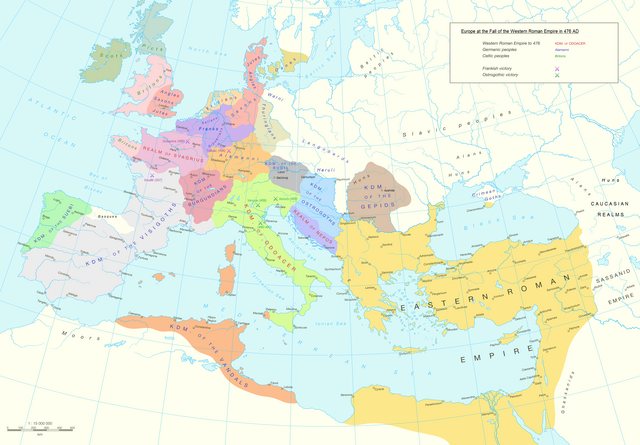Top Qs
Timeline
Chat
Perspective
Thuringii
Early Germanic people native to Thuringia (now part of Germany) From Wikipedia, the free encyclopedia
Remove ads
The Thuringii, or Thuringians were a Germanic people who lived in their own kingdom in what is now Central Germany. They are first mentioned in written records starting in the fifth century, during a period when the Huns were the most influential force in Central Europe and the Western Roman Empire lost control of this region. The kingdom was not mentioned during the reign of Attila (reigned 434–453), or during the conflicts between the small kingdoms which formed immediately after his death. The kingdom's early history and boundaries are uncertain. However, the medieval kingdom, and the modern German federal state which is still called Thuringia, lies between the Harz in the north, and the Thuringian forest in the south.
A request that this article title be changed to Thuringi is under discussion. Please do not move this article until the discussion is closed. |


The medieval Thuringian kingdom came into conflict with the Merovingian Franks, and it later became a stem duchy within the Frankish realm.
Remove ads
Name origins
Summarize
Perspective
The Thuringians do not appear in classical Roman texts under that name. This has led to several proposals connecting them to peoples know from earlier periods.
- In older scholarship it has traditionally been presumed that they were the remnants of the Hermanduri. Johann Kaspar Zeuss for example proposed that the last part of the name (Duri) was the tribal name. Two objections to this tradition have been explained by Matthias Springer.[1][2] Firstly linguistically, the pronunciation of the "th" sound in the Latin name for Thuringians is believed to have been like an English "th", but this sound could not have evolved from d-sounds in Germanic. Secondly geographically, the Hermunduri and Thuringi are not known to have lived in the same region. Tacitus, in his Germania, describes the Hermunduri in about 100 AD living in a region stretching from an area where the Elbe starts, all the way to the Danube where it formed the northern boundary of the Roman province of Rhaetia. This is far to the south of Thuringia.
- Another early people sometimes proposed as forerunners of the Thuringians are the Teuriochaemae, who were described by Claudius Ptolemy as living just north of what he called the "Sudetes" mountains in the second century. According to this proposal, "Chaemae" may represent a version of the Germanic word for "home".
- Since the late 20th century a new proposal (or old proposal with new support) has been that the Thuringi were actually descended somehow from the Tervingians, who were a Gothic people who entered central Europe from the east during the period of Hunnic dominance.
- Another old proposal which has renewed support is that they may be the same as the Torcilingi (or Thorcilingi) who were a people (or tribe or dynasty) mentioned only by Jordanes, and authors who drew upon his works, when describing Odoacer. Jordanes referred to Odoacer once as "king of the Torcilingi", once as the "king of the Thorcilingi and Rogi" (regis Thorcilingorum Rogorumque), and once as being "of the stock of Rogus of the Thorcilingi" (genere Rogus Thorcilingorum).[3]
Remove ads
First appearances
Summarize
Perspective

The name of the Thuringians appears to have first been mentioned in the veterinary treatise (Mulomedicina) of Vegetius, written about 383-450 AD. The text specifically mentions Thuringian horses, which it pairs together with the Burgundian horses: “the Thuringian and the Burgundian horses … can be recognized by their patient endurance of poor treatment” (Toringos dehinc et Burgundiones iniuriae tolerantes). Historians such as Matthias Springer have noted that other early medieval evidence also exists which implies a connection between the Thuringians and Burgundians.[4]
The second mention of the Thuringians is as allies of Attila the Hun who joined his invasion of Gaul in 451. Sidonius Apollinaris listed them among the invaders writing only a few years later, in Gaul itself.[5] From this it can be inferred that the Thuringians were present in the Battle of the Catalaunian Plains.[6]
The first near contemporary source to describe the location of the Thuringians is the early 6th century writer Eugippius, who was writing about the 460s and 470s. He reported that the Thuringians carried out raids over the Danube, into Roman imperial territory near Passau and Linz, implying that they lived close to the Danube at this time. Eugippius had lived in this region until the death of Saint Severinus of Noricum in 482.[6]
The formation of the Thuringian kingdom may have had also been influenced by two longer-known tribes more associated with the eastern bank of the lower Elbe river, northeast of Thuringia, because the Carolingian law code written for them was called the "law of the Angles and Varini that is the Thuringians". Much earlier, in his Germania for example, Tacitus had grouped the Anglii and Varini among the more distant Suebic tribes, living beyond the Elbe, and near a sea where they worshipped a goddess called Nerthus. These two tribes are among Germanic groups known to have been found north of the Danube in this period.
During the reign of Childeric I, Gregory of Tours and Fredegar record that the Frankish King married the runaway wife of the King of the Thuringians, but the story may be distorted. (For example, the area of Tongeren, now in Belgium, may have been intended.[7]
More clearly, correspondence is recorded with a kingdom of Thuringians by Procopius and Cassiodorus during the reigns of Theoderic the Great (454–526) and Clovis I (approx. 466–511), after the downfall of Attila and Odoacer.[8]
Remove ads
Political history
Summarize
Perspective

The Thuringii established an empire in the late fifth century. It reached its territorial peak in the first half of the sixth before it was conquered by the Franks in 531–532. Examination of Thuringian grave sites reveal cranial features which suggest the strong presence of Hunnic women or slaves, perhaps indicating that many Thuringians took Hunnic wives or Hunnic slaves following the collapse of the Hunnic Empire.[9] There is also evidence from jewellery found in graves that the Thuringians sought marriages with Ostrogothic and Lombard women.[citation needed] Under the leadership of Alboin, a large group of Thuringii joined the Lombards on their migration into Italy.[10] The Lombard king Agilulf (590–616) was of Thuringian descent.[11][12]
After their conquest, the Thuringii were placed under Frankish dukes, but they rebelled and had regained their independence by the late seventh century under Radulf.[13] Towards the end of this century, parts of Thuringia came under Saxon rule.
By the time of Charles Martel and Saint Boniface, they were again subject to the Franks and ruled by Frankish dukes, with their seat at Würzburg in the south. Under Martel, the Thuringian dukes' authority was extended over a part of Austrasia and the Bavarian plateau. The valleys of the Lahn, Main, and Neckar rivers were included. The Naab formed the south-eastern border of Thuringia at the time. The Werra and Fulda valleys were within it also and it reached as far as the Saxon plain in the north. Its central location in Germania, beyond the Rhine, was the reason it became the point d'appui of Boniface's mission work.
The Thuringii had a separate identity as late as 785–786, when one of their leading men, Hardrad, led an abortive insurrection against Charlemagne. The Carolingians codified the Thuringian legal customs (but perhaps did not use them extensively) as the Lex Thuringorum and continued to exact a tribute of pigs, presumably a Merovingian imposition, from the province. In the tenth century, under the Ottonians, the centre of Thuringian power lay in the north-east, near Erfurt. As late as the end of the tenth century, the porcine tribute was still being accepted by the King of Germany.
Remove ads
Ecclesiastical history
Christianity had reached the Thuringii in the fifth century, but their exposure to it was limited. Their real Christianisation took place, alongside the ecclesiastical organisation of their territory, during the early and mid eighth century under Boniface, who felled their "sacred oak" at Geismar in 724, abolishing the vestiges of their paganism.
In the 1020s, Aribo, Archbishop of Mainz, began the minting of coins at Erfurt, the oldest market town in Thuringia with a history going back to the Merovingian period. The economy, especially trade (such as with the Slavs), greatly increased after that.
Remove ads
Social history
The Thuringian nobility, which had an admixture of Frankish, Thuringian, and Saxon blood, was not as landed as that of Francia. There was also a larger population of free peasant farmers than in Francia, though there was still a large number of serfs. The obligations of serfs there were also generally less oppressive. There were also fewer clergymen before Boniface came. There was a small number of artisans and merchants, mostly trading with the Slavs to the east. The town of Erfurt was the easternmost trading post in Frankish territory at the time.
Remove ads
Historiography
The history of the Thuringii is best known from the writings concerning their conquerors, the Franks. Gregory of Tours, a Gallo-Roman, includes the nearest account in time of the fall of the Thuringian Empire. Widukind of Corvey, writing in tenth-century Saxony, inundates his similar account with various legends.
The Thuringii make brief appearances in contemporary Italian sources when their activities affect the land south of the Alps. Procopius, the Eastern Roman author, mentions them and speaks of their fall. The seventh-century Origo Gentis Langobardorum mentions a king of the Thuringii, Fisud, as a contemporary of Theudebert I.
Remove ads
Notes
Sources
Further reading
Wikiwand - on
Seamless Wikipedia browsing. On steroids.
Remove ads
